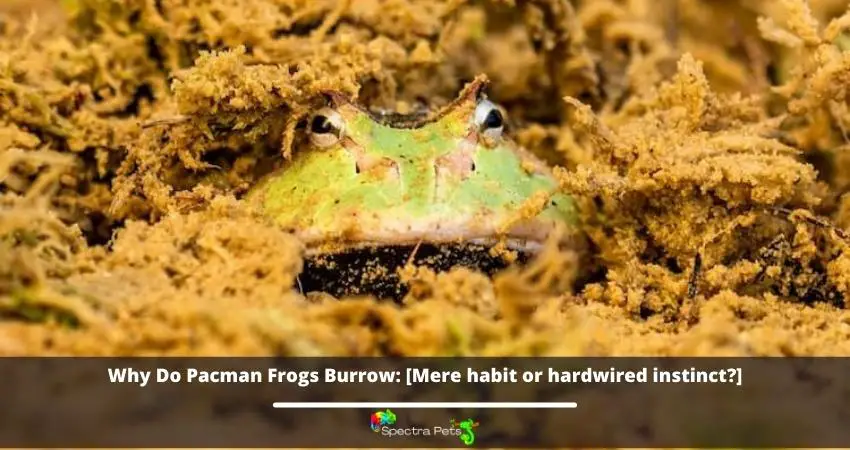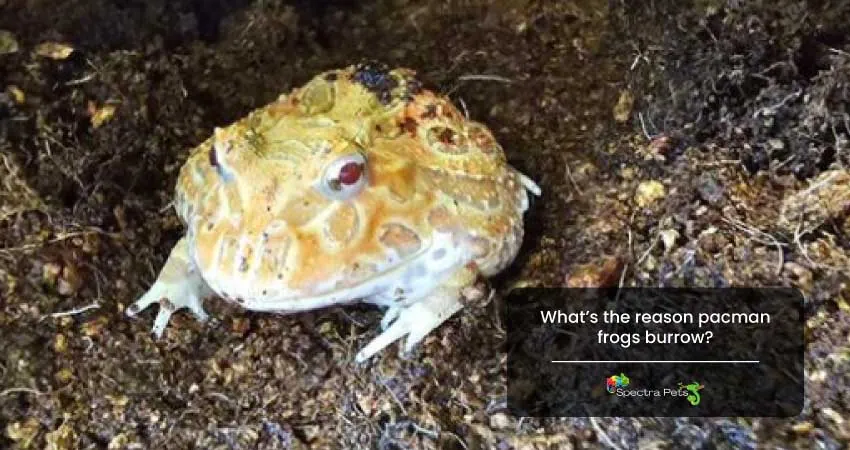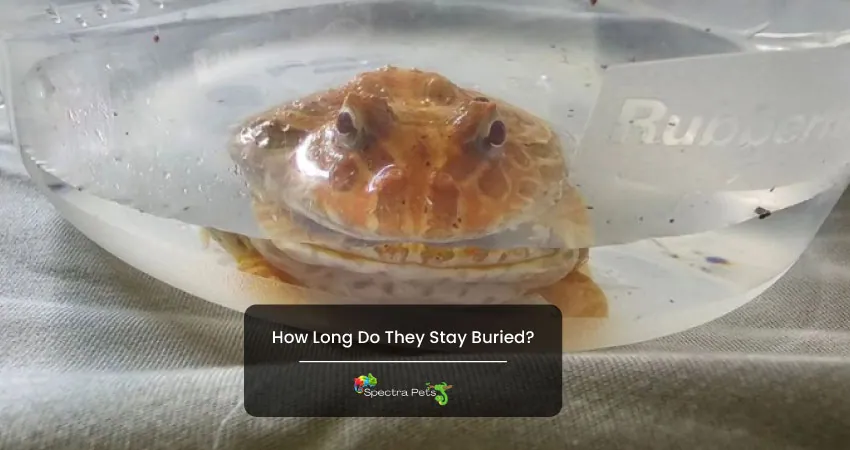Famed for their distinctive appearance and intriguing behavior, Pacman frogs, scientifically known as Ceratophrys, have gained popularity both in research and as exotic pets. Named after the beloved 1980s video game character due to their wide bodies and expansive mouths, these South American horned frogs have a fascinating trait – burrowing.
In the wild, Pacman frogs inhabit the lush, humid rainforests of South America, a habitat teeming with diverse flora and fauna. Adapting to this rich yet challenging environment, these frogs developed unique behavioral strategies. One such strategy is burrowing, a behavior essential for their survival.
Their tendency to burrow, however, isn’t just a random quirk. It’s an intricate behavior influenced by various environmental and physiological factors. In a study published in the Journal of Herpetology, it was observed that Pacman frogs employ burrowing as a means of predator evasion, temperature regulation, and a hunting technique.
This article explores the fascinating reasons behind the burrowing behavior of Pacman frogs, analyzing how factors like temperature, humidity, food availability, life stages, and overall well-being interact to shape this distinctive behavior.

What’s the reason pacman frogs burrow?
Through extensive research, I have discovered numerous compelling reasons behind the burrowing behavior of Pacman frogs. Just like any other creature on Earth, these little amphibians rely on their instinctual need to survive. Let me shed light on some of the definitive reasons that drive their burrowing tendencies.
1. Natural Instinct To Hide Themselves
Pacman frogs possess a natural instinct to burrow themselves under the substrate as a means of hiding and camouflage. This behavior allows them to conceal themselves from potential predators and blend into their surroundings. In their native rainforest habitats, the dense foliage and forest floor provide ample opportunities for these frogs to burrow and remain unseen.
When Pacman frogs are kept in captivity, their innate instinct to hide through burrowing still persists. Even in a protected environment under human observation, these frogs demonstrate a strong drive to seek cover by burrowing beneath substrates such as leaf litter, soil, or moss. This behavior mimics their natural habitat, providing them with a sense of security and comfort.
It is important to note that while this instinctual behavior is common among Pacman frogs, the extent and frequency of burrowing may vary depending on individual temperament, environmental conditions, and overall well-being of the frog. Some frogs may be more inclined to burrow regularly, while others may exhibit this behavior less frequently.
2. To Secure Itself From The Predator
In addition to providing camouflage, burrowing serves as a vital defense mechanism for Pacman frogs against potential predators. When these frogs perceive a threat or sense an unsafe environment, they instinctively seek refuge by burrowing into the ground. This innate behavior is deeply ingrained in their wild nature and plays a crucial role in their survival.
In their natural habitats, where predation is a constant risk, Pacman frogs rely on their burrowing abilities to evade detection by predators. By quickly disappearing beneath the substrate, they significantly reduce their visibility and vulnerability. The loose soil or leaf litter acts as a protective shield, shielding them from the prying eyes of predators and increasing their chances of survival.
Even in captivity, Pacman frogs retain their instinctual response to potential dangers. If they perceive any threatening or unwelcoming conditions, they may resort to burrowing as a means of self-defense. This behavior is a testament to their innate survival instincts and serves as a crucial adaptation for their overall well-being.
3. To Hunt The Insects
Pacman frogs exhibit a unique hunting strategy that involves utilizing their burrowing abilities to their advantage. When these frogs are hunting, they burrow themselves under the substrate, strategically positioning themselves to ambush their prey. This behavior is an integral part of their eating habits and aids in their successful foraging.
By burrowing beneath the substrate, Pacman frogs create a hidden vantage point from which they can patiently wait for unsuspecting prey to approach. Their ability to remain concealed within the soil or leaf litter allows them to go unnoticed by potential prey, increasing their chances of a successful ambush.
This hunting technique is commonly observed in animals that employ sit-and-wait strategies to capture their prey effectively. Pacman frogs are skilled at blending into their surroundings, utilizing their burrows as a tactical advantage. Once an unsuspecting insect or small prey ventures near the frog’s position, it swiftly lunges forward, using its large mouth to capture the prey.
This behavior highlights the Pacman frog’s remarkable adaptation and ability to exploit its burrowing instincts for both defense and hunting purposes. Similar to other camouflage-dependent predators such as Chameleons, Leaf Tail Geckos, and Mossy frogs, Pacman frogs capitalize on their burrowing skills to optimize their hunting efficiency and increase their chances of securing a meal.

4. To Maintain Temperature
Another interesting reason for digging under the substrate is temperature drop or raise. When the temperature of the surroundings becomes unfavorable for your Pacman frog, it used to burrow itself so that it can find its temperature favorable.
In their native rainforest habitat, Pacman frogs experience a range of temperatures throughout the day and over different seasons. These frogs often burrow into the ground to escape the heat of the day, emerging when the temperature drops.
| Average Daily Temperature | Burrowing Behavior |
|---|---|
| Above 30°C (86°F) | Increased burrowing to escape heat |
| 20-30°C (68-86°F) | Optimal range, varied burrowing |
| Below 20°C (68°F) | Increased burrowing to retain heat |
When exposed to high temperatures, Pacman frogs burrow into the cooler soil to avoid overheating. Conversely, during colder periods, they burrow to avoid losing body heat, utilizing the soil’s insulation properties.
In captivity, Pacman frogs continue to exhibit this temperature-driven burrowing behavior. Keeping them in an enclosure with a temperature gradient (a cooler side and a warmer side) allows them to regulate their body temperature as they would in the wild, often leading to burrowing on the cooler side during warmer periods and the warmer side during cooler periods.
5. Age Factor And Life Stages
Just like any other living creature, the Pacman frog’s habits, including burrowing, can change as it transitions from one life stage to another.
Juvenile Pacman frogs, being smaller and more vulnerable, often burrow deeper than their adult counterparts. As they grow larger and more capable of defending themselves, the need to burrow for protection tends to decrease, but doesn’t disappear entirely.
During periods of rapid growth or development, such as after eating a large meal or during times of shedding skin, Pacman frogs often burrow for extended periods.
Female Pacman frogs may also show changes in burrowing behavior related to breeding and egg-laying. They may dig shallow nests in the substrate to lay their eggs, providing a safe and humid environment for the eggs to develop.
How does Humidity Affect the Burrowing Behavior of Pacman Frogs?
Humidity plays an equally important role in the burrowing behavior of Pacman frogs. As creatures that naturally inhabit high-humidity environments, these frogs rely on burrowing to retain moisture and stay hydrated.
Humidity helps maintain the skin health of Pacman frogs. These amphibians breathe partially through their skin, and a higher humidity level ensures their skin stays moist and functioning efficiently.
Pacman frogs tend to burrow deeper when the humidity is low. This is because the soil retains more moisture the deeper you go, so burrowing deeper can help them to stay hydrated.
In captivity, humidity levels need to be closely monitored and maintained. Low humidity levels can cause stress and health issues, often leading to an increase in burrowing behavior as the frog attempts to find a more comfortable environment.
Burrowing Activity Vs. Eating Habits
The burrowing behavior of Pacman frogs is closely linked to their sit-and-wait hunting strategy. Also, the availability of food can impact the frequency and depth of burrowing.
Pacman frogs are ambush predators, which means they often sit still and wait for their prey to come close. Burrowing into the substrate allows them to blend into their environment and launch a surprise attack when prey is within reach.
Food availability can also influence the depth and frequency of burrowing. When food is scarce, Pacman frogs might burrow deeper and stay hidden longer to conserve energy.
In captivity, consistent feeding schedules can influence a Pacman frog’s burrowing behavior. A well-fed Pacman frog may not burrow as often or as deeply as it would in the wild. But be aware, overfeeding can lead to obesity, so it’s essential to find a balance.
How should I deal with a burrowing Pacman frog?
A natural instinct is to burrow under a substrate, as I have mentioned previously. It will be better for you to take precautions after knowing the reasons why they burrow themselves.
On this ground, you can help your Pacman frog by regulating favorable temperatures while it is in captivity. As they search for a cool substrate when the temperature is hot and vice versa. Sometimes temperature might be a serious issue for them and quick changes in temperature may affect their health.
On the other hand, others have reported that their Pacman frogs do not burrow down under the substrate at all. While this might seem a problem because this goes against their natural instinct.

But, there is no problem concerning how they will breathe under the substrate. You might know that frogs can breathe through their skin. So burrowing does not make any hindrance to breathing.
In case, the tank and substrate are both hot then they will not burrow themselves under the rubbish. They will wait until the temperature comes down. In that case, you can provide for them another shelter and it is recommended to change the substrate or make the substrate wet and cool so that it will be a good place for them to lower their body temperature.
Read Next:
1. Best Substrate For Pacman Frog
2. Pacman Frog Habitat Setup
How Long Do They Stay Buried?
It is very important to know how long they stay buried. If you want to nourish a Pacman frog or learn its biology, then you will see that the juvenile one is staying longer under the substrate than the adult one.
As for how long they stay, we can’t provide the answer in one line because it is a bit complex. A Pacman frog generally emerges from the substrate when it is hungry or if it sees its prey is relatively close to him. Also, it is possible for them to remain under the substrate even a week or more without coming out.

Additionally, it has been found that the Pacman frog emerges at night, but this does not happen in every case. So it is hard to give a definite time frame. All these depend upon two things —
1. Health Condition
That means, if a Pacman frog feels unfavorable temperature then it chooses the way to burrow itself under the substrate.
2. Environmental Conditions
Unexpected attack by a predator, pursue a way for food by burrowing itself Pacman frog awaits so that its prey can come near and finally burrowing itself under substrate is a common nature of a Pacman frog, etc. These things come under this heading.
However, the majority of the owners of Pacman frogs have reported that their frogs generally stay for a few days. In most cases, Pacman frogs dig and go under five inches of substrate so that they can cool down their body temperature and consume their reserves of food.
Final Words
Finally, every Pacman frog owner should understand why Pacman Frogs Burrow and how long do they stay under the substrate. This will enable frog owners to release their worries and take the proper measures to mitigate the problem.

